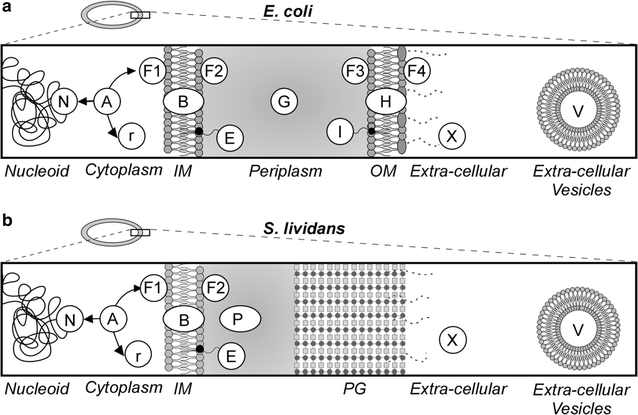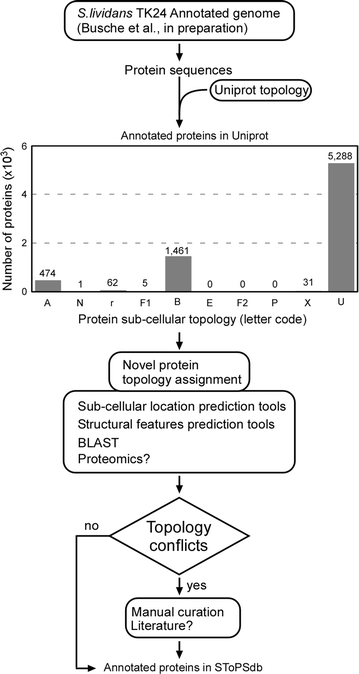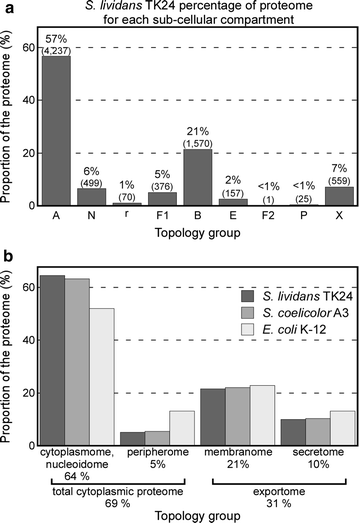Comprehensive subcellular topologies of polypeptides in Streptomyces
- PMID: 29544487
- PMCID: PMC5853079
- DOI: 10.1186/s12934-018-0892-0
Comprehensive subcellular topologies of polypeptides in Streptomyces
Abstract
Background: Members of the genus Streptomyces are Gram-positive bacteria that are used as important cell factories to produce secondary metabolites and secrete heterologous proteins. They possess some of the largest bacterial genomes and thus proteomes. Understanding their complex proteomes and metabolic regulation will improve any genetic engineering approach.
Results: Here, we performed a comprehensive annotation of the subcellular localization of the proteome of Streptomyces lividans TK24 and developed the Subcellular Topology of Polypeptides in Streptomyces database (SToPSdb) to make this information widely accessible. We first introduced a uniform, improved nomenclature that re-annotated the names of ~ 4000 proteins based on functional and structural information. Then protein localization was assigned de novo using prediction tools and edited by manual curation for 7494 proteins, including information for 183 proteins that resulted from a recent genome re-annotation and are not available in current databases. The S. lividans proteome was also linked with those of other model bacterial strains including Streptomyces coelicolor A3(2) and Escherichia coli K-12, based on protein homology, and can be accessed through an open web interface. Finally, experimental data derived from proteomics experiments have been incorporated and provide validation for protein existence or topology for 579 proteins. Proteomics also reveals proteins released from vesicles that bleb off the membrane. All export systems known in S. lividans are also presented and exported proteins assigned export routes, where known.
Conclusions: SToPSdb provides an updated and comprehensive protein localization annotation resource for S. lividans and other streptomycetes. It forms the basis for future linking to databases containing experimental data of proteomics, genomics and metabolomics studies for this organism.
Keywords: Database; Membranome; Peptidoglycan; Protein subcellular localization; Protein subcellular topology; Proteome annotation; S. lividans TK24; Sec system; Secretome; Signal peptide; Sortase; TAT system.
Figures



Similar articles
-
Extensive Reannotation of the Genome of the Model Streptomycete Streptomyces lividans TK24 Based on Transcriptome and Proteome Information.Front Microbiol. 2021 Apr 14;12:604034. doi: 10.3389/fmicb.2021.604034. eCollection 2021. Front Microbiol. 2021. PMID: 33935985 Free PMC article.
-
Proteome-wide subcellular topologies of E. coli polypeptides database (STEPdb).Mol Cell Proteomics. 2014 Dec;13(12):3674-87. doi: 10.1074/mcp.O114.041137. Epub 2014 Sep 10. Mol Cell Proteomics. 2014. PMID: 25210196 Free PMC article.
-
Quantitative Proteomics Analysis Confirmed Oxidative Metabolism Predominates in Streptomyces coelicolor versus Glycolytic Metabolism in Streptomyces lividans.J Proteome Res. 2017 Jul 7;16(7):2597-2613. doi: 10.1021/acs.jproteome.7b00163. Epub 2017 Jun 15. J Proteome Res. 2017. PMID: 28560880
-
Streptomyces genetics: a genomic perspective.Crit Rev Biotechnol. 2003;23(1):1-27. doi: 10.1080/713609296. Crit Rev Biotechnol. 2003. PMID: 12693442 Review.
-
An insight into the "-omics" based engineering of streptomycetes for secondary metabolite overproduction.Biomed Res Int. 2013;2013:968518. doi: 10.1155/2013/968518. Epub 2013 Sep 2. Biomed Res Int. 2013. PMID: 24078931 Free PMC article. Review.
Cited by
-
Amphotericin B biosynthesis in Streptomyces nodosus: quantitative analysis of metabolism via LC-MS/MS based metabolomics for rational design.Microb Cell Fact. 2020 Jan 31;19(1):18. doi: 10.1186/s12934-020-1290-y. Microb Cell Fact. 2020. PMID: 32005241 Free PMC article.
-
Enhanced protein secretion in reduced genome strains of Streptomyces lividans.Microb Cell Fact. 2024 Jan 5;23(1):13. doi: 10.1186/s12934-023-02269-x. Microb Cell Fact. 2024. PMID: 38183102 Free PMC article.
-
Secretome Dynamics in a Gram-Positive Bacterial Model.Mol Cell Proteomics. 2019 Mar;18(3):423-436. doi: 10.1074/mcp.RA118.000899. Epub 2018 Nov 29. Mol Cell Proteomics. 2019. PMID: 30498012 Free PMC article.
-
Streptomyces as Microbial Chassis for Heterologous Protein Expression.Front Bioeng Biotechnol. 2021 Dec 21;9:804295. doi: 10.3389/fbioe.2021.804295. eCollection 2021. Front Bioeng Biotechnol. 2021. PMID: 34993191 Free PMC article. Review.
-
The Cellular Mechanisms that Ensure an Efficient Secretion in Streptomyces.Antibiotics (Basel). 2018 Apr 14;7(2):33. doi: 10.3390/antibiotics7020033. Antibiotics (Basel). 2018. PMID: 29661993 Free PMC article. Review.
References
MeSH terms
Substances
LinkOut - more resources
Full Text Sources
Other Literature Sources

